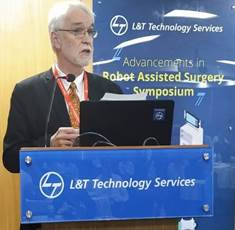LTTS hosts symposium on future in medical robotics with University of Illinois, IISc Bangalore, KAIST
Korea, PSG College of Technology and PSG Institute of Medical Science as participants
L&T Technology Services Limited expects almost 50% of all surgeries to be robot assisted by 2025, as AI makes robots precise enough to facilitate complex surgeries.
LTTS organized an ‘Experience Walk-through’ as part of a Symposium on Advancement in Robot-assisted surgery to enable participants to get hands-on experience with cutting-edge products and solutions in the medical and medical equipment field.
The event was graced by prominent dignitaries and speakers in the field of Robotics, Clinical Robotics, Medicine & Healthcare and Medical Equipment from IIT Madras, IIT Delhi, IISc Bangalore, PSG Institute of Medical Science and Research, Coimbatore, PSG College of Technology, Navtat Solutions and Simulated Surgical Systems.
The symposium was dedicated to discussing the possibilities and advancements in the field of Medical Robotics. Robotics is a state-of-the-art technology that offers superior vision, improved flexibility and great accuracy surpassing humans while performing complex tasks. Robotic assistance in surgery, rehabilitation efforts and therapeutic practices have made humans realize the need for research and technological progress in the field.
A few products showcased at the symposium include:
- Robotic-Endo Training Kit: A compact, cost-effective surgical robot, for affordable and advanced laparoscopic and endoscopic surgical training, developed in association with KAIST, PSG and assisted by the Global Innovation & Technology Alliance (GITA)
- Chemistry Analyzer: A fully automated clinical chemistry analyzer, with intelligent multitasking software
- 3-Part Cell Counter: India’s first indigenously built and cost-effective blood cell counter, developed in association with Agappe Diagnostics Ltd
- Chest X-Ray: An AI-based image analysis and pneumonia detection solution to help radiologists identify the symptoms and detect the disease in its initial phase


